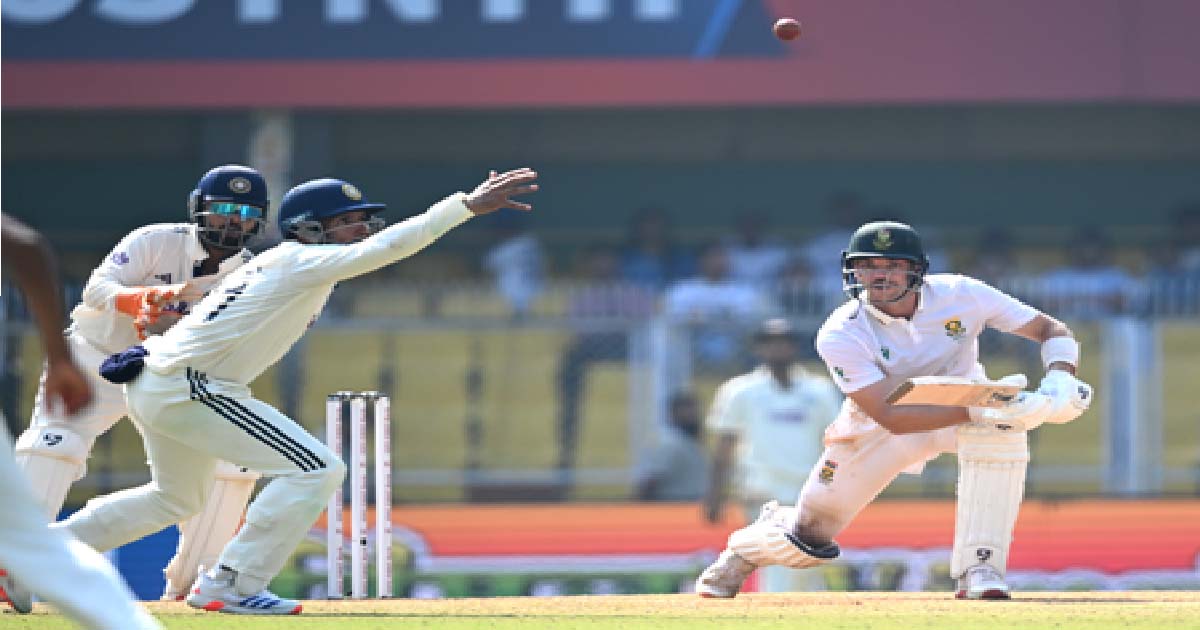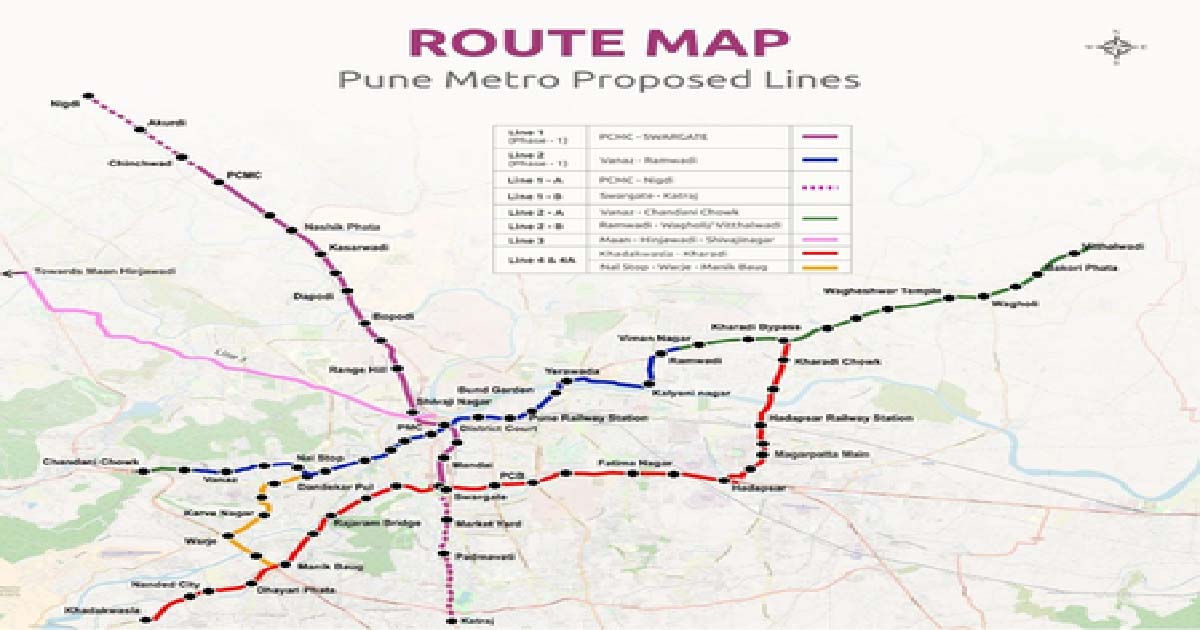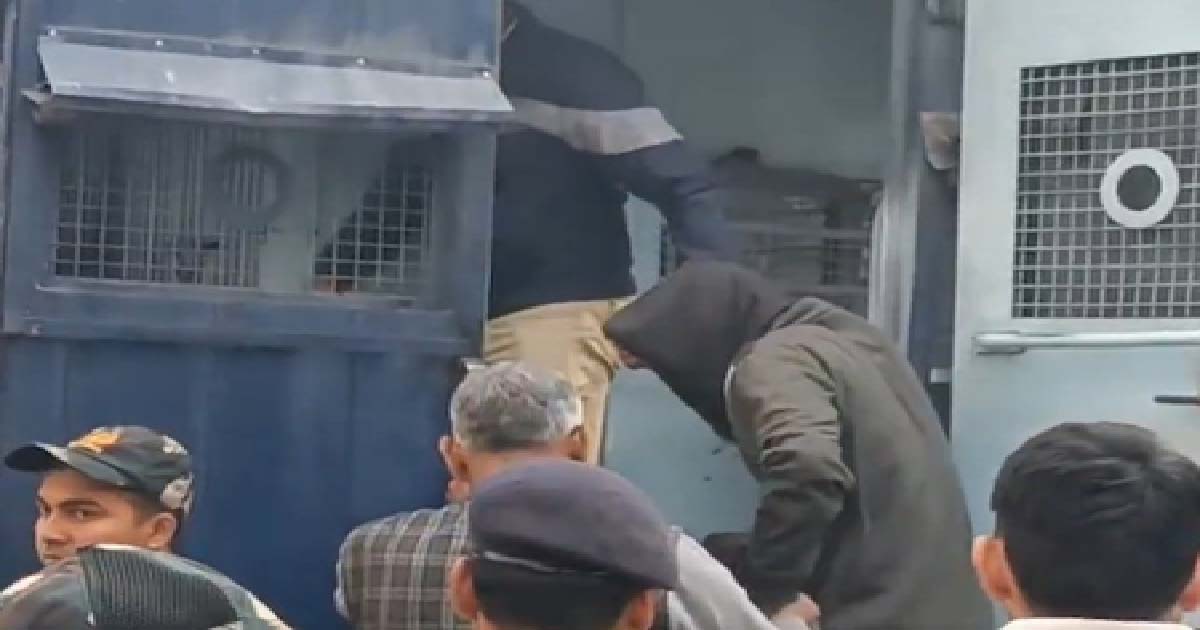National News
2nd Test: Stubbs’ 94, Zorzi’s 49 help South Africa set India target of 549 runs

Guwahati, Nov 25: India found moments of success through Ravindra Jadeja and Washington Sundar, but South Africa continued to command proceedings on Day 4 of the second Test, courtesy of a brilliant 94 by Tristan Stubbs as the youngster’s knocked helped the team stretch their lead to over 500 runs and eventually declaring at 260/5 to set India a target of 549 runs.
The day began with the visitors resuming at 26/0, and openers Ryan Rickelton and Aiden Markram looking assured as they raised the score to 58 before India’s spinners made their impact. Rickelton, who benefited from early luck, was dismissed for 35 while attempting an aggressive shot, handing Jadeja his first breakthrough. The left-arm spinner struck again soon after, removing Markram for 29 with a sharp turn that troubled the batters throughout the morning.
Washington Sundar complemented Jadeja superbly, bowling a disciplined spell with subtle variations in pace that kept South Africa’s scoring in check. His persistence paid off when he removed captain Temba Bavuma, who flicked a simple catch to leg slip. Despite a few missed run-out opportunities, India looked energetic in the field and kept the visitors’ progress steady rather than free-flowing.
At 107/3 by tea, the session appeared evenly balanced as Tony de Zorzi and Tristan Stubbs steadied the innings, combining caution with calculated aggression. Both batters found regular boundaries and shifted momentum again in South Africa’s favour heading into the second session.
De Zorzi and Stubbs batted with purpose, sweeping, cutting, and rotating strike as if playing on a surface entirely different from the one tormenting India. Every boundary struck through the gaps felt like a reminder: South Africa were not just surviving, they were progressing. Zorzi’s sweeps scythed through the leg side with authority, while Stubbs absorbed pressure before unleashing strokes that drained India’s early energy.
After tea, Jadeja trapped de Zorzi lbw just shy of a half-century. Yet even that wicket felt like a pause rather than a shift. Stubbs marched on to his fifty, unhurried and unbothered, as Wiaan Mulder joined him to push the lead past 500 with quiet confidence.
With four sessions remaining in the match, the Proteas showed no inclination to declare early, adding 113 runs in the second session for the loss of just one wicket. India even turned to part-timer Yashasvi Jaiswal for an over, but South Africa’s control remained unchallenged.
At lunch, South Africa had moved to 220/4 in 70 overs, firmly on top as India faced a huge scare.
As Stubbs approached a century, the Proteas continued their batting innings after lunch, despite many expecting a declaration. The young player entered the nervous nineties, and South Africa watched to see if he could reach 100 before the declaration. However, as soon as he was dismissed, Bavuma indicated the batters to come back in, thereby closing their innings at 260/5 and setting the hosts a massive 549-run target.
While a win looks difficult here, Team India will look to bat throughout the remainder of Day 4 and on Wednesday, the final day of the game, to draw the match. South Africa, meanwhile, will aim to bowl out the hosts again to add a historic victory under their belt, while also gaining some crucial World Test Championship points.
Brief Scores: South Africa 489 and 260/5d in 78.3 overs (Tristan Stubbs 94, Tony de Zorzi 49; Ravindra Jadeja 4/62) lead India 201 all out in 83.5 overs (Yashasvi Jaiswal 58, Washington Sundar 48; Marco Jansen 6-48, Simon Harmer 3-64) by 548 runs.
Business
Union Cabinet approves Pune Metro Rail Project Phase 2 with Rs 9,857 crore outlay

New Delhi, Nov 26: In a major boost for the public transport network in Pune, the Union Cabinet, chaired by Prime Minister Narendra Modi, on Wednesday approved Line 4 (Kharadi–Hadapsar–Swargate–Khadakwasla) and Line 4A (Nal Stop–Warje–Manik Baug) with Rs 9,857.85 crore outlay under Phase 2 of the Pune Metro Rail Project.
According to the Cabinet, this is the second major project approved under Phase-2, following the sanction of Line 2A (Vanaz–Chandani Chowk) and Line 2B (Ramwadi–Wagholi/Vitthalwadi). With this latest approval, Pune Metro’s network will expand beyond the 100-km milestone, a significant step in the city’s journey towards a modern, integrated, and sustainable urban transit system.
Spanning 31.636 km with 28 elevated stations, Line 4 and 4A will connect IT hubs, commercial zones, educational institutions, and residential clusters across East, South, and West Pune.
The project will be completed within five years at an estimated cost of Rs 9,857.85 crore, to be jointly funded by the Centre, the Maharashtra government, and external bilateral/multilateral funding agencies.
These lines are a vital part of Pune’s Comprehensive Mobility Plan (CMP) and will seamlessly integrate with operational and sanctioned corridors at Kharadi Bypass and Nal Stop (Line 2), and Swargate (Line 1).
“They will also provide an interchange at Hadapsar Railway Station and connect with future corridors towards Loni Kalbhor and Saswad Road, ensuring smooth multimodal connectivity across metro, rail, and bus networks,” a Cabinet communique said.
The project will be implemented by the Maharashtra Metro Rail Corporation Limited (Maha-Metro), which will carry out all civil, electrical, mechanical, and systems works.
Pre-construction activities such as topographical surveys and detailed design consultancy are already underway, according to the Cabinet.
According to projections, the daily ridership on Line 4 and 4A combined is expected to be 4.09 lakh in 2028, rising to nearly 7 lakh in 2038, 9.63 lakh in 2048, and over 11.7 lakh in 2058.
Of this, the Kharadi–Khadakwasla corridor will account for 3.23 lakh passengers in 2028, growing to 9.33 lakh by 2058, while the Nal Stop–Warje–Manik Baug spur line will rise from 85,555 to 2.41 lakh passengers over the same period.
These projections highlight the significant growth in ridership expected on Line 4 and 4A over the coming decades.
With Line 4 and 4A, Pune will not just get more metro tracks but will also gain a faster, greener, and more connected future. These corridors are designed to give back hours of commuting time, reduce traffic chaos, and provide citizens with a safe, reliable, and affordable alternative.
Crime
Red Fort blast: Accused Soyab sent to 10-day NIA custody

New Delhi, Nov 26: The National Investigation Agency (NIA) was granted a 10-day custody of Soyab, the accused in the Delhi terror blast case, who was arrested in Faridabad earlier on Wednesday.
Soyab was presented before the Patiala House Court, which approved his transfer to NIA custody for 10 days.
Additionally, another key accused, Aamir Rashid Ali, had his NIA custody expiring on the same day. He was also presented before the court, which extended his custody by an additional seven days.
The NIA, earlier in the day, arrested Soyab, a resident of Faridabad’s Dhoj, for harbouring terrorist Dr Umar Muhammad, also known as Umar Un Nabi, immediately before the Delhi terror bomb blast.
Soyab is the seventh person to be arrested in connection with the case.
According to the NIA, he not only harboured Umar before the attack but also provided logistical support crucial to the execution of the November 10 car bombing near the Red Fort that killed several people and left many others injured.
Before this arrest, the NIA had taken six of Umar’s close aides into custody as part of ongoing investigations under case number RC-21/2025/NIA/DLI.
The NIA stated that it is actively pursuing multiple leads related to the suicide bombing and has been conducting coordinated searches across several states with the assistance of local police forces. The agency said its objective is to identify and apprehend all members linked to the larger terror network responsible for the attack.
Meanwhile, ongoing investigations have revealed chilling details about terrorist Umar’s methods and preparations.
According to interrogation inputs from arrested members of the terror module, Umar maintained what investigators describe as a “mobile workstation” — a large suitcase containing bomb-making tools, chemical compounds and containers. He carried it with him wherever he went.
Umar, a medical professional associated with Al-Falah University in Faridabad, reportedly conducted chemical tests in his room on campus before creating the final Improvised Explosive Device (IED).
One of the arrested suspects, Dr Muzamil Shakeel, also affiliated with the same university, confirmed to interrogators that Umar experimented with substances that were later used in the blast.
Business
Assam saw major drop in child marriage cases under BJP govt: CM Sarma

Guwahati, Nov 26: Assam Chief Minister Himanta Biswa Sarma on Wednesday underscored a “major turnaround” in the state’s battle against child marriage, saying a combination of stringent enforcement and systemic reforms has led to significant declines in the underage marriages and boosted legal accountability.
CM Sarma claimed that according to NFHS‑4 (2015-16) data, 31.8 per cent of women in Assam aged 20–24 were married before turning 18 – a rate that exceeded the national average.
Moreover, district-level fact sheets had recorded alarming prevalence in districts such as Dhubri, South Salmara, Barpeta and Nagaon, as high as 40–55 per cent.
However, the state now claims a decisive shift. Between 2023 and 2024 alone, more than 8,600 arrests were made in coordinated crackdowns under both the Protection of Children from Sexual Offences Act (POCSO) and the Prohibition of Child Marriage Act (PCMA).
According to the Chief Minister, in 2022 the number of cases registered stood at 224, sharply up from just 149 in 2021, indicating a steep rise in enforcement.
CM Sarma said, “Beyond arrests, Assam has formed district-level task forces, headed by superintendents of police, to track and intercept impending child marriages. Community-level workers – including ASHAs, Anganwadi staff and schoolteachers – are now required to report suspected cases in real time.”
“Several districts have also reportedly established digital databases and child-protection tracking mechanisms,” he added.
The CM claimed that these measures have borne fruit: In hotspot districts, the incidence of child marriage fell by 8–17 per cent within a year, and more than 3,000 planned child marriages were prevented in 2023–24 alone.
Notably, the Assam government’s recent actions – from sustained crackdowns to setting up institutional safeguards – reflect a far more aggressive stance on child marriage than seen in earlier years, when the practice was largely treated as a social issue rather than a crime.
-

 Crime3 years ago
Crime3 years agoClass 10 student jumps to death in Jaipur
-

 Maharashtra1 year ago
Maharashtra1 year agoMumbai Local Train Update: Central Railway’s New Timetable Comes Into Effect; Check Full List Of Revised Timings & Stations
-

 Maharashtra1 year ago
Maharashtra1 year agoMumbai To Go Toll-Free Tonight! Maharashtra Govt Announces Complete Toll Waiver For Light Motor Vehicles At All 5 Entry Points Of City
-

 Maharashtra1 year ago
Maharashtra1 year agoFalse photo of Imtiaz Jaleel’s rally, exposing the fooling conspiracy
-

 National News1 year ago
National News1 year agoMinistry of Railways rolls out Special Drive 4.0 with focus on digitisation, cleanliness, inclusiveness and grievance redressal
-

 Maharashtra1 year ago
Maharashtra1 year agoMaharashtra Elections 2024: Mumbai Metro & BEST Services Extended Till Midnight On Voting Day
-

 National News1 year ago
National News1 year agoJ&K: 4 Jawans Killed, 28 Injured After Bus Carrying BSF Personnel For Poll Duty Falls Into Gorge In Budgam; Terrifying Visuals Surface
-

 Crime1 year ago
Crime1 year agoBaba Siddique Murder: Mumbai Police Unable To Get Lawrence Bishnoi Custody Due To Home Ministry Order, Says Report












